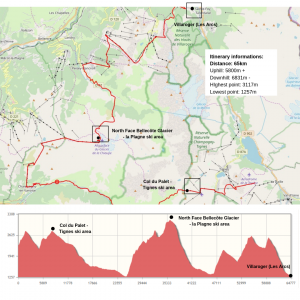1 day: 68kms of skiing, 5800m descent, 4 resorts
The Tarentaise is an alpine valley in the heart of the Savoie region of France to the south of the Beaufort and Mont Blanc mountain ranges. Within the Tarentaise, you will find a large number of the best known ski resorts in the Alps but also a reserve, containing natural, unspoiled landscapes that it is possible to traverse on foot in summer (using the GR5 route) and on skis during the winter. The Tarentaise Tour takes in several of the aforementioned ski resorts: Val d’Isere, Tignes, Champagny la Plagne and Les Arcs before finishing in Villaroger village. You will need to buy a lift pass for Val d’Isere, Tignes and Paradiski and organise a bus/taxi at Champagny and a taxi to get back to Val d’Isere at the end of the day. No need to stress, your Oxygene instructor can organise all the logistics for you. So wax your skis, clip into your boots and get ready for the adventure of a lifetime as you cross the Tarentaise Valley.
08:45: Coffee, croissant and sun cream
The day starts in Val d’Isere. Amongst our team of 10 experienced skiers keen for adventure are 3 Oxygene instructors. ABS bags* on, snacks in our bags, coffee and croissants consumed we’re off at 08:50 sharp for the opening of the Olympique gondola. We warm our legs up cruising down the piste to the Tommeuses chairlift which we ascend making the transition from Val d’Isere in to Tignes. We then take the Tichot chair followed by the button lift to the top of the Col du Palet peak at 2650m altitude. 3 beeps for each transceiver**, we double check our equipment***, take a photo of the magnificent view and off we go.
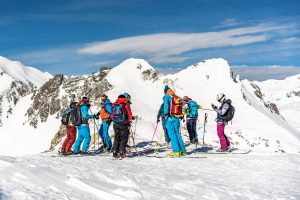
Away from the crowds in the quiet of the mountains
We begin our descent heading in the direction of Champagny. 1,500m of vertical drop over 15kms of skiing, we are in a winter wonderland of fresh powder and spring snow. We cross several snow slips on the southerly facing slopes and push on our poles to slide across the snow as it warms up in the shining sun.
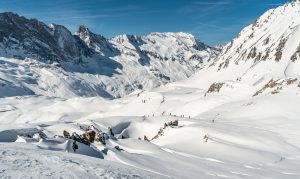
There’s no such thing as something for nothing and we have to sweat a bit for our taste of the wilderness. For me, there is nothing quite like being able to slide along in silence, without a worry in the world, surrounded by snowy mountain peaks to the right and the glaciers of the Roche de Tougne and Volnets on the left. The sky starts to cloud over a little, bringing a freshness to the air as we arrive on the plateau of the Laissonnay cross-country skiing area. We have a 4km tour to get to the road where our pre-organised bus will be waiting for us. We assume the skating position on our skis and use our poles to keep momentum as we catch the confused eye of several ski-tourers and cross-country skiers. One older gentleman asked me where we had come from. Taking a break to catch my breath I explained. He was surprised that we were so far from our starting point and wished me good luck. 3 more kilometres, a litre of sweat and plenty of puffing and panting later, we reached the road where our driver, Denis, was waiting.
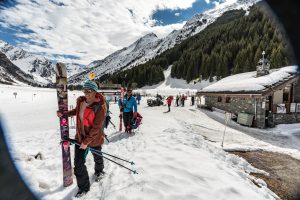
Into Paradiski and the mythical North Face
From the bottom of Champagny we take the Borseliers III lift up and into La Plagne. Our stomachs are crying out for food but there’s only time for a quick Mars Bar and off we head again. Since the conditions allowed it and we hadn’t had our fill of the off-piste we headed to the Bellecote North Face. This was a big first for me, the opportunity to ski down this challenging freeride run with its 1,800m of vertical descent. You have to earn your turns however. A short walk is required to get from the top of the gondola or chairlift depending which route you take.
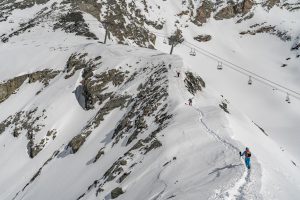
With skis on our backs we walk along the ridge line to get to the top of the face at 3,100m altitude. The Bellecote glacier to our right and a dizzying panorama to our left, an exceptional off-piste itinerary awaits us. We need to have our wits about us however. One of our instructors, Remi, who worked in La Plagne before transferring to Val d’Isere, knows this route well and guides us with precision. The snow is excellent and we analyse the snow pack, choosing our lines carefully.
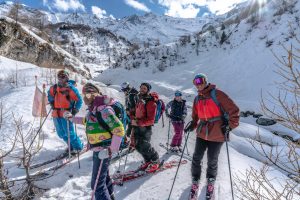
The run ends with us skiing along the Nant Fesson stream, through the fir trees to a terrace where we refresh ourselves whilst waiting for the Peisey bus that will take us to Les Arcs. We toast the stunning descent we have just shared and the aches and pains we have assured ourselves tomorrow. Cheers!
Les Arcs, last ski area on our epic adventure
As a general rule and when the weather allows it we would finish the tour with a final off-piste descent called the Grand Col behind the Aiguille Rouge. But the weather takes a turn for the worse and before long a snowstorm accompanies us on the slopes of Les Arcs. We decide to stay on piste an put on a spurt of speed to reach Villaroger. The fog comes down and the snow and wind form mini tornadoes on the pistes. We don’t see a single person. It’s 5pm and the slopes are closing one by one. We continue to descend and reach the rain / snow limit, heading down the last slope with no visibility whatsoever. In less than 5 minutes we’re soaked but thankfully reach our destination which is both warm and dry. We receive a warm welcome from Michel at the La Ferme restaurant and the wonderful smells from the kitchen reawaken our hunger. In no time at all we are devouring cheese, local cured meat and tartiflette washed down with a bottle (or two!) of local wine. Mission accomplished! We have crossed the Tarentaise, shared an amazing experience together and discovered the most incredible scenery. And me? I’m ready to do it all over again as soon as possible.
Has the Tarentaise Tour tickled your fancy for adventure? Are you a strong skier / snowboarder looking to tackle some of the best off-piste in the Alps?
* ABS bag – a rucksack containing an airbag that you deploy in the event of being caught in an avalanche. The inflated bag helps you float on top of the snow preventing you from being buried. Oxygene provides airbags for all off-piste guiding sessions
** Transceiver – a small device that you wear on your person whilst skiing off-piste that emits a signal allowing you to be found or look for other members of your party in the event of an avalanche.
*** Double check – a way of verifying that everyone’s transceivers are working correctly in search and emit modes.
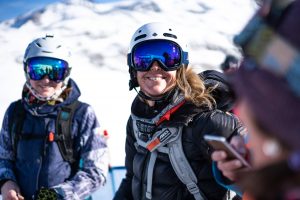

Blog by Marion Clerc
Originally from Annecy, Marion started skiing from a very young age. She has always preferred powder runs to slalom runs. She has worked for Oxygene for 3 years and spends her free time exploring the resorts of the Tarentaise with our instructors to find the best runs.


